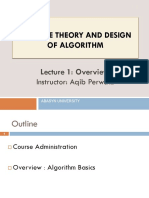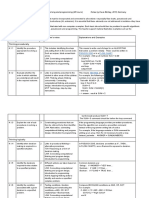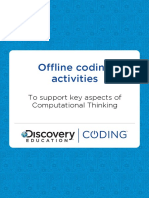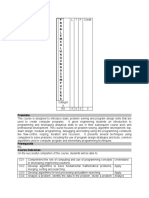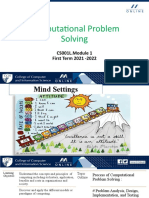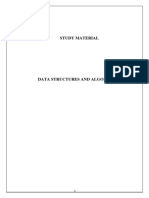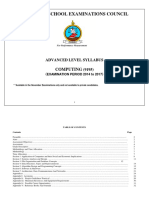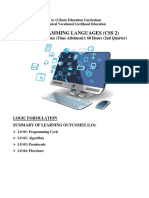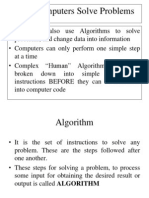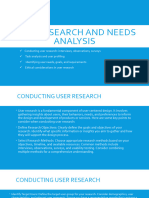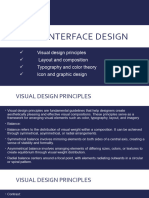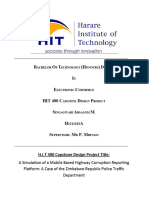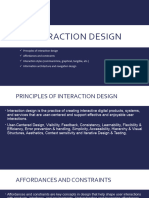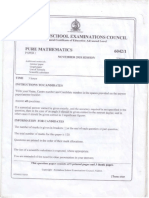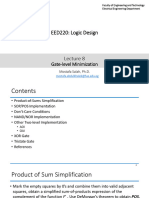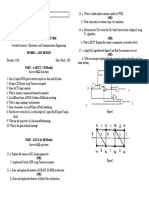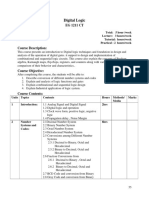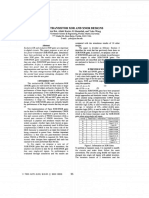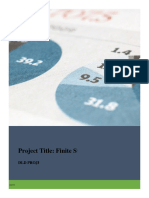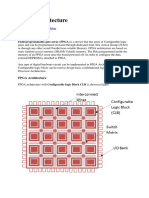FORDRIDGE SENIOR SCHOOL
Form 4
COMPUTER SCIENCE SCHEME
Mr. Kavara
�Form 3 Computer Science Scheme
AIMS
The aims are to enable students to develop:
• Computational thinking skills
• An understanding of the component parts of computer systems and how they interrelate.
• Acquire knowledge on the range of computer applications, their social and economic implications.
• An understanding of the development and use of automated and emerging technologies.
TOPICS
• Algorithm design & programming concepts
• Boolean Logic
• Data Representation
|Page
�Form 3 Computer Science Scheme
Competences (skills,
Cycle1
Topic Objectives Methodology/ Activities knowledge and Reference/ Source of matter Media/ resources
Ending
attitudes)
-Overhead Projector
January - Laptop
• Multimedia to beam up -Giving examples of
2025 By the end of the lesson • Teacher’s notes - Desktop
the notes and videos algorithms
PROBLEM learners should be able to: • internet -Computer images/
SOLUTION, • Teacher explains, let the -Discussing sequence
• Construct • text books pictures
ALGORITHM learners write the notes, construct
pseudocodes - the national syllabus, - White board
DESIGN & and/ or to print some -Interpreting a sequence
PROGRAMMING • Developing - ICDL softcopy
handouts. algorithm
CONCEPTS pseudocodes to
• Teacher allows/ gives
solve problems
room for questions.
• Multimedia to
• Design flow beam up the notes • Algorithm Tools - Laptop
PROBLEM charts and videos • Flow chart - Desktop
SOLUTION, • Breaking down • Teacher explains, • Pseudocodes
-Computer images/
ALGORITHM problem into let the learners pictures
DESIGN &
sub-problems write the notes, • Top down and bottom - White board
PROGRAMMING
CONCEPTS • Use top down and/ or to print up design
approach to some handouts.
represent an • Teacher allows/
algorithm. gives room for
questions.
By the end of the lesson • Multimedia Tutorial
PROBLEM learners should be able to: • Teacher explains, let the -Solving problems • Print and Electronic
SOLUTION, -explain the syntax and learners write the notes, using a sequence media
ALGORITHM
DESIGN &
semantics of the and/ or to print some algorithm structure • Algorithm charts
PROGRAMMING programming language handouts. -Dry running a • Smart Draw
CONCEPTS • Teacher allows/ gives sequence algorithm • MS Visio
room for questions. • Internet
|Page
�Form 3 Computer Science Scheme
Cycle 1 General Evaluation Individual Evaluation
Ending
Lesson 1 Almost half of the class comprehended the use of descriptions and how to Kimberly Mafurise and Shafiqah Mavhima were able to explain sequence structures
solve a problem using descriptions but some students had difficulties in and to identify scenarios of where and when they are used. Donniel Simarida and
writing a pseudo code for a given problem. Nkosilathi Dhliwayo were able to write a description and convert a description to a
pseudocode. Christian Mavagwa and Ryn Nkala had difficulties in writing a
pseudocode from a given description.
Lesson 2 Most students understood how to modularize a given complex problem Jaden Nazerere and Lovejoy Magweva were very participative and contributed
using top down approach. significantly in the lesson and were able to perform top down approach on a given
question in the class. Anicia Mpofu and Brooklyn Mabeka had difficulties in
performing top down design on paper.
Lesson 3 Almost every student shows exceptional skill in tackling algorithm By providing targeted guidance and opportunities for practice, facilitator can help
problems, showcasing advanced problem-solving abilities. Very few Nicole Chiku improve in dry running sequence algorithms. Tawana Chindenda and
students failed to tackle complex sequence algorithm, evidencing the need Doniel Suwarita exhibits a clear grasp of the conversion process, showcasing precision
for revision. and consistency in dry running a sequence algorithm.
Lesson 4 Almost three quarters of the class excelled in control structures , Tariro Chiriseri and Simbarashe Mahwinya faced difficulties in implementing control
consistently producing correct results. structures when solving a problem and required simplified explanations to enhance
comprehension. The active engagement in class discussions of Marlon Chinyowa and
Doniel Suwarita contributed significantly to the lesson success.
|Page
�Form 3 Computer Science Scheme
Cycle 2 Competences (skills, Reference/ Source of
Topic Objectives Methodology/ Activities Media/ resources
Ending knowledge and attitudes) matter
By the end of the lesson • Multimedia to beam up • Solving basic
Practical • Teacher’s notes • Multimedia Tutorial
learners should be able the notes and videos mathematical problems
Assessment: • internet • Print and Electronic
January to: • Teacher explains, lets the • Testing and debugging
2025 • text books media
PROBLEM • Use top down approach learners to write the
- the national syllabus, • Algorithm charts
SOLUTION, to represent an notes, and/ or to print
- internet • Smart Draw
Algorithm Design algorithm some handouts.
- text books • MS Visio
And Problem-Solving • Teacher allows/ gives
- ICDL softcopy • Internet
room for questions.
DATA By the end of the lesson - Teacher uses overhead -Converting numbers from - the national syllabus, - Overhead Projector
REPRESENTATION learners should be able projector to beam up the one base to another - internet - Laptop
to: notes, explains, lets the - text books - Desktop
-Converting keyboard
-convert numbers from learners to write the notes, - ICDL softcopy - Computer images/
MAIL-MERGE and/ or to print some characters to binary pictures
denary to binary and
handouts. numbers using ASCII - White board
vice-versa.
-Teacher allows/ gives
character codes
-convert keyboard room for questions.
Demonstrations -Adding and subtracting
characters to ASCII code
binary numbers
DATA By the end of the lesson -Converting numbers from - the national syllabus, - Overhead Projector
REPRESENTATION learners should be able -Teacher allows/ gives one base to another - internet - Laptop
to: room for questions. - text books - Desktop
-Converting keyboard
-convert numbers from Project-based learning - ICDL softcopy - Computer images/
• Question and answer characters to binary pictures
binary to hexadecimal • Discussion - White board
numbers using ASCII
and vice-versa. •Research & Presentations
character codes
-convert keyboard
MAIL-MERGE -Design a multi-recipient
characters to ASCII code letter using mail-merge
|Page
�Form 3 Computer Science Scheme
Cycle 2 General Evaluation Individual Evaluation
Ending
Lesson 1 Most students demonstrates a solid understanding Shafiqah Mavhima and Patrick Mashayanyika exhibits a commendable proficiency across various evaluation
of the binary addition process, consistently criteria, demonstrating a solid grasp of base conversion, accurate ASCII character conversion, and binary
arriving at correct results. Student shows arithmetic operations. Continued encouragement and challenges can further nurture Lovejoy Magweva and
proficiency in carrying out binary addition
Kimberly Mafurise’s skills in adding binary numbers.
operations efficiently and accurately.
Lesson 2 Almost three quarters of the class effectively Shekinah Kadonga and Nkosinathi Dhliwayo requires additional practice and support in mastering base
carried out addition principles to binary numbers, conversion, ASCII character conversion, and binary arithmetic operations. While improvements are evident in
showcasing a clear grasp of the concept. Students binary addition, further attention is needed to enhance proficiency in binary subtraction.
demonstrated confidence in adding binary
numbers and showcases a strong problem-solving
ability in this area.
Lesson 3 Most students demonstrates a strong Tammy Marembo and Tariro Chiriseri finds it challenging to convert keyboard characters to binary numbers
understanding of ASCII character codes and accurately, indicating a need for improvement.
effectively converts keyboard characters to binary
numbers. Some were having challenges in
accurately translating keyboard characters to
binary representations using ASCII codes.
Lesson 4 Most of the students confidently applies ASCII Success Makamba and Assith Andrea responds well to a supportive learning environment and benefits from one-
character codes to convert keyboard characters to on-one assistance to clarify doubts and reinforce learning. Anicia Mpofu and Jayden Msenda shows potential for
binary numbers, displaying advanced skills in this growth and improvement and consistent practice in binary conversions.
area.
|Page
�Form 3 Computer Science Scheme
Competences (skills,
Cycle 3 Reference/ Source of
Topic Objectives Methodology/ Activities knowledge and Media/ resources
Ending matter
attitudes)
DATA By the end of the lesson - Teacher uses overhead -Adding and subtracting - the national syllabus, - Overhead Projector
REPRESENTATION learners should be able projector to beam up the notes, binary numbers - internet - Laptop
to: explains, lets the learners to - text books - Desktop
February -add binary numbers write the notes, and/ or to print - ICDL softcopy - Computer images/
2025
-subtract binary numbers some handouts. pictures
-Teacher allows/ gives room - White board
for questions.
Demonstrations
DATA By the end of the lesson - Teacher uses overhead -Adding and subtracting - the national syllabus, - Overhead Projector
REPRESENTATION learners should be able projector to beam up the notes, binary numbers - internet - Laptop
to: explains, lets the learners to - text books - Desktop
-add binary numbers write the notes, and/ or to print - ICDL softcopy - Computer images/
MAIL-MERGE some handouts. pictures
-subtract binary numbers
-Teacher allows/ gives room - White board
for questions.
Demonstrations
DATA - Teacher uses overhead -Adding and subtracting - the national syllabus, - Overhead Projector
REPRESENTATION projector to beam up the notes, binary numbers - internet - Laptop
explains, lets the learners to - text books - Desktop
By the end of the lesson
write the notes, and/ or to print -Design a multi- - ICDL softcopy - Computer images/
learners should be able
some handouts. recipient letter using pictures
to:
-Teacher allows/ gives room mail-merge - White board
-add binary numbers
for questions.
-subtract binary numbers Project-based learning
MAIL-MERGE • Discussion
•Research & Presentations
|Page
�Form 3 Computer Science Scheme
Cycle 3 General Evaluation Individual Evaluation
Ending
Lesson 1 Most students excelled in adding binary numbers, Kevin Chawafambira and Shaqinah Mavhima demonstrates exceptional proficiency in adding and subtracting
consistently producing correct binary binary numbers accurately and showcased a deep understanding of the concept. Jayden Nazerere and Tammy
representations. Very few students had difficulties Marembo struggled with accurately subtracting binary numbers They require extra support and guidance to
in understanding binary subtraction.
improve understanding and proficiency in binary subtraction.
Lesson 2 Almost every student shows exceptional skill in Denzel Mumba and Jayden Nazerere demonstrates a willingness to learn but may benefit from personalized
binary subtraction, showcasing advanced instruction to grasp the concepts effectively as they were facing challenges on complex binary subtraction Kevin
problem-solving abilities in this area. Very few Chawafambira showcased binary subtraction skills on the whiteboard, displaying a strong understanding of
students failed to tackle complex binary complex binary addition and subtraction, consistently producing accurate results.
subtraction, evidencing the need for revision.
Lesson 3 Almost three quarters of the class excelled in Doniel Suwarita and Nkosinathi Dhliwayo presented on complex binary subtraction showing great understanding
subtracting binary numbers, consistently of the concept. Christian Mavangwa and Brooklyn Mabeka shows persistence in learning but needs patient
producing correct results. guidance and additional resources to overcome challenges in binary subtraction.
|Page
�Form 3 Computer Science Scheme
Cycle 4 Competences (skills, Reference/ Source of
Topic Objectives Methodology/ Activities Media/ resources
Ending knowledge and attitudes) matter
BOOLEAN By the end of the week -Research & Presentations -Constructing logic circuits - the national syllabus, - Overhead Projector
LOGIC learners should be able -Teacher introduces the - internet - Laptop
to: concepts of OR and AND. - text books - Desktop
- Teacher demonstrates OR
- ICDL softcopy - Simulators
- Identify and gate and AND gate by use of
electrical model - White board
February use standard
2025 symbols for - projector presentation of
logic gates. simulation.
- Define and
understand
the functions
of the logic
gates.
BOOLEAN By the end of the week - Teacher develops the concept -Constructing logic circuits - the national syllabus, - Overhead Projector
LOGIC learners should be able of truth table for OR gate - internet - Laptop
to: - learners develop truth - text books - Desktop
table for AND gate.
- Use of logic gates to - ICDL softcopy -Simulators
- learners develop truth
create given logic - White board
table for NAND gate.
circuits. - learners develop truth
- Complete a truth table for OR gate.
table and write a logic
expression.
BOOLEAN By the end of the week Constructing logic circuits - the national syllabus, - Overhead Projector
LOGIC learners should be able - Teacher develops the concept and truth tables - internet - Laptop
to: of truth table for OR gate - text books - Desktop
- learners develop truth table - ICDL softcopy - Computer images/
for NOR , XOR, XNOR gate pictures
- Learners use appropriate - Simulators
hardware or simulation - White board
software to develop
understanding of the functions
of the NOT, NAND, NOR and
XOR (ExOR) logic gates.
- construct each gate’s
truth table.
|Page
�Form 3 Computer Science Scheme
Cycle 4 General Evaluation Individual Evaluation
Ending
Lesson 1 Most students encountered difficulties in Kevin Chawafa and Mavhima Shafiqah displayed a strong understanding of converting a combination of logic
converting a combination of logic gates to a truth gates to a truth table, consistently producing accurate results.
table, showing inconsistencies in the process.
They required additional explanations and
examples to enhance understanding of logic gate
conversions and truth tables.
Lesson 2 Almost half of the class shows improvement in Mabeka Brooklyn and Simbarashe Mahwinya faces challenges in accurately converting a combination of logic
understanding logic gate combinations, with the gates to a truth table, indicating a need for improvement. Kevin Chawafambira demonstrates excellent analytical
potential to enhance accuracy in truth table skills in dissecting complex logic gate combinations and translating them into a comprehensive truth table.
constructions. The other half needs targeted
support to further develop skills in converting
logic gates to truth tables effectively.
Lesson 3 Most students improved in converting logic gates Keith Kajokota learns best through hands-on activities as he presented on the operations of the Truth tables and
to a truth table which was notably seen during practical examples to consolidate understanding of logic conversions. Patrick Mashayanyika and Tawana
class presentations. Very few had challenges in Chindenda efficiently applied logical principles to derive truth table outcomes, showcasing proficiency in logical
complex understanding and applying logic gate reasoning.
conversions.
Lesson 4 Nearly three quarters of the class are now able to Anicia Mpofu and Kimberly Mafuruse proved to benefit the most from interactive sessions as they participated
tackle complex logic gates conversion to truth the most during the lesson.
tables and very few needs detailed explanations Tariro Chiriseri and Brooklyn Mabeka would benefit from regular practice and review sessions to improve
and examples to solidify understanding of logic proficiency in converting logic gates to a truth table effectively.
gate combinations and their translation to a truth
table.
|Page
�Form 3 Computer Science Scheme
Competences (skills,
Cycle 4 Reference/ Source of
Topic Objectives Methodology/ Activities knowledge and Media/ resources
Ending matter
attitudes)
BOOLEAN By the end of the week - Teacher uses overhead projector to -Discussing computer - the national syllabus, - Overhead Projector
LOGIC learners should be able beam up the notes, explains, lets the crime and its effects - internet - Laptop
to: learners to write the notes, and/ or to - text books - Desktop
-Applying data protection
print some handouts. - ICDL softcopy - Computer images/
- Identify and use
•Research & Presentations measures pictures
March standard
-Learners work out the simple logic - White board
2025 symbols for circuits required to create NAND and
logic gates. NOR gates using AND, OR and NOT
- Define and gates and test them.
understand the
functions of the
logic gates.
BOOLEAN By the end of the week - Teacher develops the concept of -Constructing logic - the national syllabus, - Overhead Projector
LOGIC learners should be able truth table for OR gate; learners - internet - Laptop
circuits and Truth tables.
to: develop truth table for AND gate. - text books - Desktop
- learners develop truth table for Logic
- Use of logic gates to - ICDL softcopy - Simulators
circuits.
create given logic - White board
circuits.
- Complete a truth table
and write a logic
expression.
BOOLEAN By the end of the week Work out the simple logic circuits -Constructing Truth - the national syllabus, - Overhead Projector
LOGIC learners should be able required to create NAND and NOR - internet - Laptop
to: gates using AND, OR and NOT gates
tables from logic - text books - Desktop
- and test them. circuits. - ICDL softcopy - Computer images/
pictures
- White board
|Page
�Form 3 Computer Science Scheme
Cycle General Evaluation Individual Evaluation
Ending
Lesson 1 Most students improved in converting logic gates to a truth table Patrick Mashayanyika and Simba Mufaro is making progress in comprehending the conversion
which was notably seen during class presentations. Very few had of logic gates to a truth table but may require additional practice for mastery. Lovejoy
Logic challenges in complex understanding and applying logic gate Magweva and Jayden Nazerere encountered difficulties in converting a combination of logic
Circuits conversions. gates to a truth table, showing inconsistencies in the process.
Repeat
Lesson 2 Nearly three quarters of the class are now able to tackle complex Nkosinathi and Shekinah Kadonda would benefit from ongoing encouragement and targeted
logic gates conversion to truth tables and very few needs detailed support to further develop skills in converting logic gates to truth tables effectively.
explanations and examples to solidify understanding of logic gate
combinations and their translation to a truth table.
Lesson 3 Most students encountered difficulties in grasping the conversion of Lovejoy Magweva and Tariro requires additional support and explanations to enhance
logic circuits with three inputs to a truth table, leading to comprehension of logic gate combinations and truth table generation
inaccuracies in the process. With additional examples and
assistances almost half of the class have improved.
|Page


























